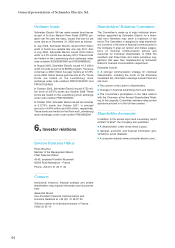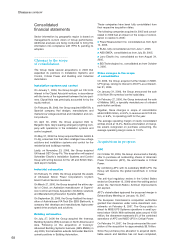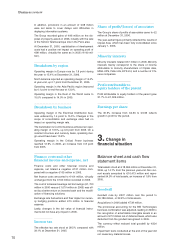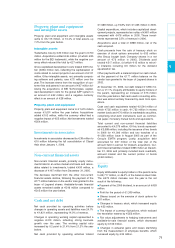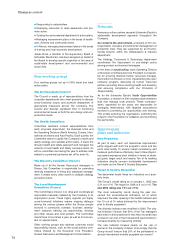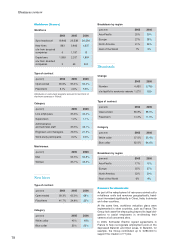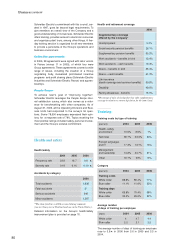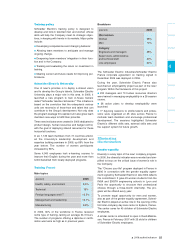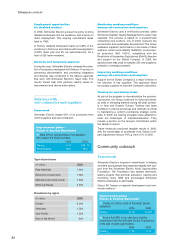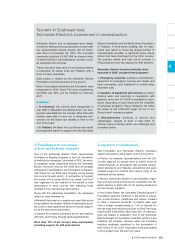APC 2006 Annual Report Download - page 76
Download and view the complete annual report
Please find page 76 of the 2006 APC annual report below. You can navigate through the pages in the report by either clicking on the pages listed below, or by using the keyword search tool below to find specific information within the annual report.
Responding to stakeholders.
Deploying resources to raise awareness and pro-
mote action.
Guiding the environmental department's action plans.
Managing improvement plans in the areas of health-
care, diversity and community action.
In France, managing improvement plans in the areas
of training and local economic development.
James Ross, a member of the Supervisory Board of
Schneider Electric SA, has been assigned on behalf of
the Board to develop specific expertise in the area of
sustainable development and environmental and
social risks.
Four working groups
Four working groups set up in 2005 impel and track
action plans.
The Environmental Council
The Council is made up of representatives from the
corporate departments who meet quarterly to discuss
cross-functional issues and promote deployment of
appropriate measures across the Company. The
Council also devotes significant time to monitoring
environmental issues at both the eco-design and eco-
production levels.
The Health Committee
Committee members include representatives from
each corporate department, the Business Units and
the Operating Divisions (North America, Europe, Inter-
national and Iberia and Asia-Pacific). Each quarter, the
Committee meets to guide the Company’s health and
safety strategy and validate action plans. It leads the
Group’s health and safety approach and manages the
network of local health and safety correspondents. An
ad hoc committee met during the year to address risks
related to a potential pandemic set off by avian flu.
The Diversity Committee (France)
Made up of all the Human Resources managers in
France, this Committee is responsible for promoting
diversity awareness in hiring and employee manage-
ment. It meets every other month to validate strategy
and action plans.
The Local Development
Committee (France)
This Committee’s mission is to drive and coordinate all
responsible measures initiated by the Company in its
employment pools. These highly regional yet highly
cross-functional initiatives require ongoing dialogue
among the various players within the Group–people
involved in community outreach, business develop-
ment, research, training, job opportunities, diversity
and other issues–and field workers. The Committee
meets three to four times a year, as well as for encoun-
ters on special topics.
Other working groups also address corporate social
responsibility issues, such as the social policies com-
mittee chaired by the Executive Vice President,
Human Resources and Managerial Communication.
Networks
Numerous culture carriers cascade Schneider Electric’s
sustainable development approach throughout the
Company.
As concerns the environment, a network of 210 cor-
respondents oversees environmental management at
production sites. They are supported by an Environ-
mental Director within the Globalization & Industry
department.
The Strategy, Customers & Technology department
coordinates the deployment of eco-design policy
among product environment managers.
In the area of social policy, each Operating Division
or Business Unit Executive Vice President is responsi-
ble for ensuring effective human resources manage-
ment within his Division or Unit, implementing the new2
company program, deploying all human resources
policies (including those covering health and diversity)
and ensuring compliance with
Our Principles of
Responsibility
.
As for the Schneider Electric Youth Opportunities
Foundation, a network of 200 volunteer team members
lead and manage local projects. These correspon-
dents, appointed for two years, are responsible for
managing relationships with targeted associations
involved in promoting job opportunities and training.
This entails selecting the organization, submitting the
project to the Foundation for validation and monitoring
the partnership.
Improvement
plans and indicators
New Reporting
As part of new2, each unit determines improvement
paths aligned with both the program’s vision and the
unit’s local reality. To ensure overall consistency and
measure performance effectively, new2’s New Report-
ing system expresses each initiative in terms of strate-
gic goals, target result and means. Ten of its tracking
indicators directly concern sustainable development
and make up the Planet & Society Barometer.
Planet & Society Barometer
The barometer tracks these ten indicators on a quar-
terly basis.
The Group’s overall rating as of January 1, 2005 was
5.21 out of 10. The target for 2008 is 8 out of 10. The
end-2006 rating was 7.01 out of 10.
The most noteworthy trends during the year con-
cerned the environmental indicators, all of which
improved, the clear upswing in the health indicator and
the 10 out of 10 rating achieved by the improvement
plan to donate equipment.
The diversity indicator was modified in 2006. The orig-
inal indicator ("ensure that 30% of the Top managers
have been in their positions for less than one year) was
a means to an end, in that it measured opportunities to
increase diversity by measuring mobility.
The new indicator focuses clearly on the role of
women in the Company. It states, more simply, that the
Group should "ensure that 20% of the participants in
annual international mobility programs are women".
Business review
74


